Rotherham United entertained Lincoln City at the New York Stadium on Saturday in a battle between two clubs who are back in the division after various lengths of time away: United returning to League One having suffered relegation from the Championship after one year back in the second division and after promotion last year, Lincoln were on their first away trip in the third tier for 20 years, last playing at this level in the 1998/99 season.
The Imps were the victors here, leaving south Yorkshire with a 0-2 win to back up their opening-day success at home to Accrington Stanley. Here, we will provide an in-depth tactical analysis of the match, with our Lincoln City analysis looking at the tactics employed by both teams and how successful they were.
Lineups
Rotherham lined up in a 4-3-3 when in possession and a 4-5-1 when not on the ball, with wide forwards Michael Smith and Kyle Vassell dropping into the position of a winger in order to give support to their full-backs. Freddie Ladapo was the central striker between the pair, whilst Matt Crooks and Shaun McDonald looked to offer support from midfield ahead of the deeper Daniel Barlaser.
As for Lincoln, they operated between a 4-2-3-1 in possession and a 4-5-1 when not, with Jack Payne and Jorge Grant – the two attackers of the three behind striker Tyler Walker – dropping in to give support. Harry Anderson moved from a traditional central midfield position to an attacking midfielder when on the ball, with defensive balance in the middle of the park offered by Michael O’Connor and Joe Morrell.
Half-space domination
A huge part of Lincoln’s ability to be successful under manager Danny Cowley is their aptitude at overloading and controlling the half-spaces both offensively and defensively. They show a huge desire to outrun and outwork opponents in order to do so, and when combined with genuine quality on the ball, makes them a supremely dangerous outfit. The numbers they get in-and-around the ball gives them a greater chance of either regaining possession if they are currently not in control of the ball, or continuing their build-up play through overloading the spaces around the man on the ball if in possession. We will examine examples of both here.
City stifled United’s attacking threat and ability to create and play by outnumbering them in such areas when the home side was on the ball. Their numerical superiority suffocates their opponents into submission as it does not let them play – as is the case in the images below.
Firstly, we can see that, having received a pass from right-back Matt Olosunde, Ladapo is outnumbered upon receiving the ball. He is being pressed from behind and so cannot turn, whilst the on-running full-back is being marshalled by Grant. Additionally, Morrell is providing support to his colleagues in front of Ladapo so that he can press the striker’s first touch and look to dispossess him in this manner. As Morrell is the free man here he is the crucial play, as it is he that is giving his side the overload and thereby the greatest chance of regaining possession.
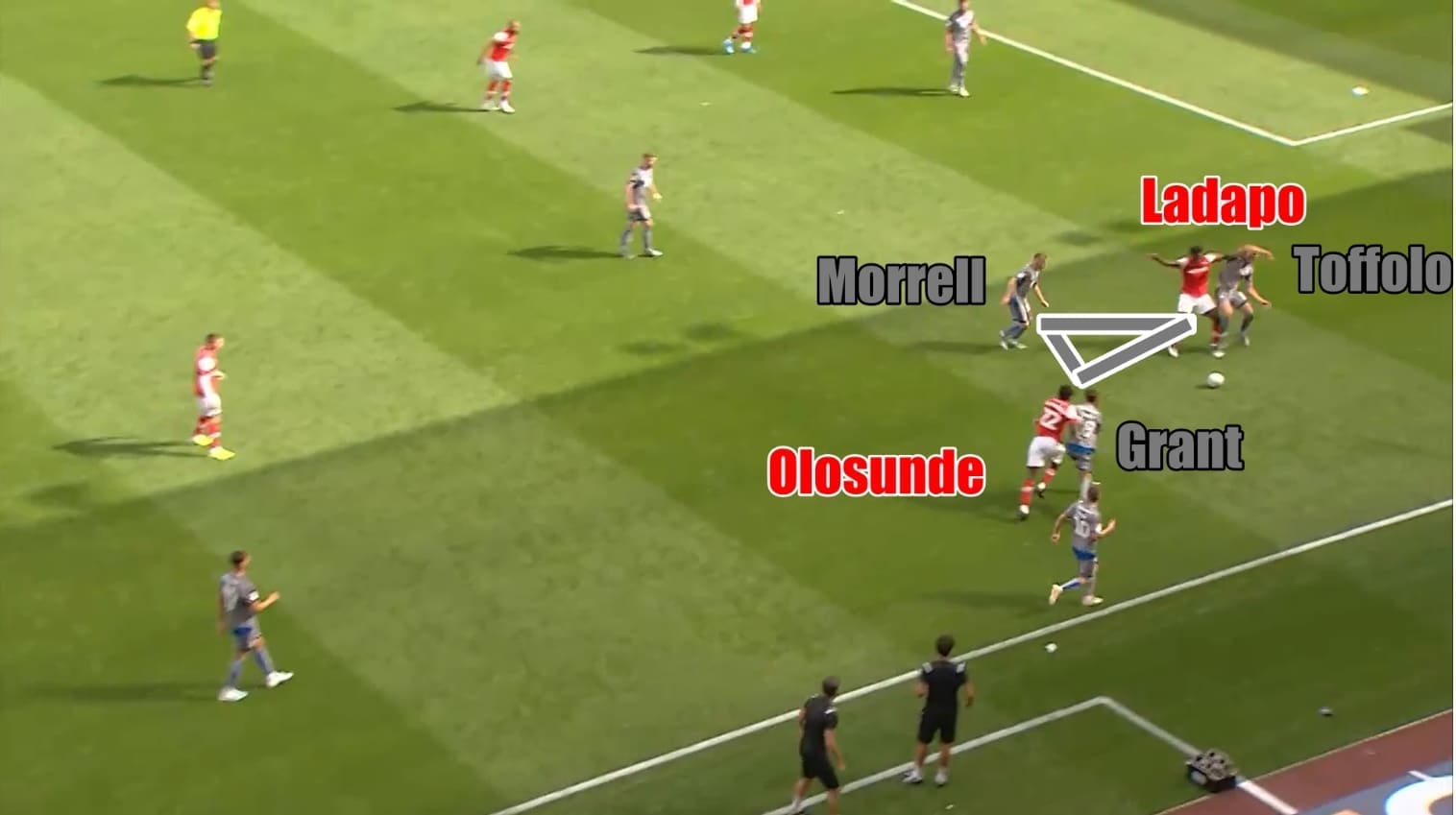
Another example is examined below, yet here, the Imps’ transitional ability is also seen.
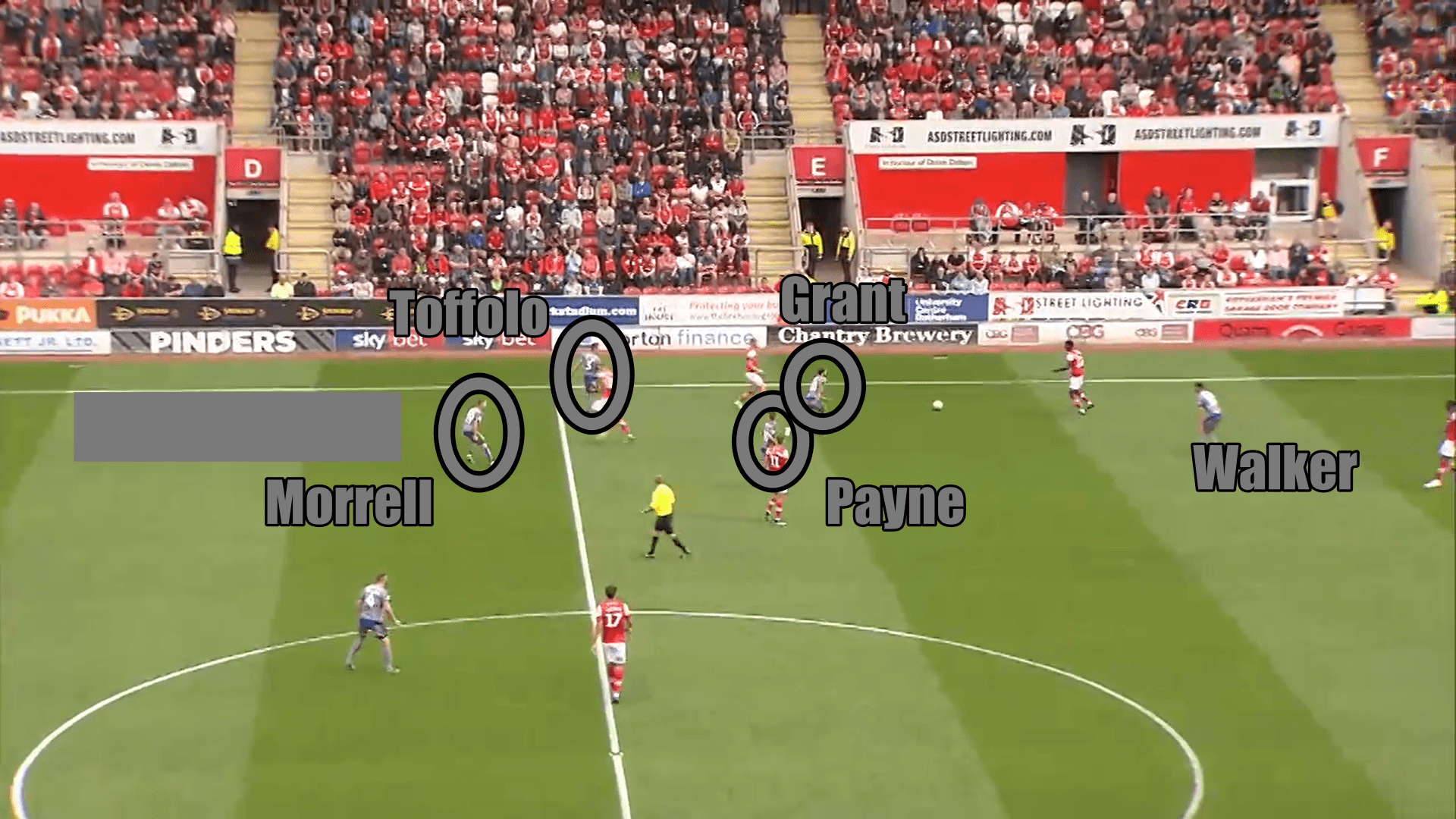
Here, there are four Imps players in the immediate vicinity of the ball (all circled) and Tyler Walker also close by, as they look to hunt for the ball and win it back. This creates a five-versus-four situation in Lincoln’s favour and thereby gives them a greater opportunity of winning the ball back. Crucial to this is the personnel involved and also positioning of individuals. All four are staggered on different vertical and horizontal passing lanes in order to cover as much space as possible and therefore give themselves a better chance of regaining the ball.
Left-back Harry Toffolo is aggressive in his positioning as he closes down the ball, however, Morrell allows such vigorous pressing due to his positioning too. He is situated so that he can cover any balls played over Toffolo’s head to a runner (highlighted by the grey box), and this then gives the full-back license to be able to harass and harry Rotherham. Had the midfielder not been able to give such protection, Toffolo may be caught in two minds as to what to do, and this would then cause the whole operation to fail. As it is, Morrell is able to either press what is in front of him should the man on the ball opt to play or short, and he can also react to a clipped ball over the press should that be chosen either.
Furthermore, the presence of Payne and Grant in the press means that Lincoln can transition rapidly and instantaneously look to run at the Millers’ defence. Both attackers are extremely skilful ball-carriers who can glide past men with ease, yet also have a great abundance of energy and zest to work hard for their side in winning the ball back. When combined, this means that when they regain possession they are already on the front foot and running at the opposing backline, and individually they have the skills to be able to take advantage of a now-recovering defence before it has a chance to fully reset – making their team a huge danger in offensive transition in the process.
As well as this, they also look to stick to these principles when in possession.
Having played the ball to Walker in the half-space – where the frontman is pinning his marker – Payne looks to instantly run off the frontman in order to give an option wide. Anderson is also providing support inside of Walker, and it is the speed of these two movements that gives Lincoln the advantage here. Upon playing the pass, Payne does not hesitate for a second in making a run off Walker, whilst Anderson advances his position slightly even before the pass has been played to Walker in preparation for such a move. The rapid recognition of this position by both Payne and Anderson allows them to overload the area around Walker as soon as he receives the ball – and crucially before Rotherham can react. It is obvious that none of the Rotherham midfielders have positioned themselves in such a way in order to account for these movements, and this thereby gives Lincoln the upper hand.
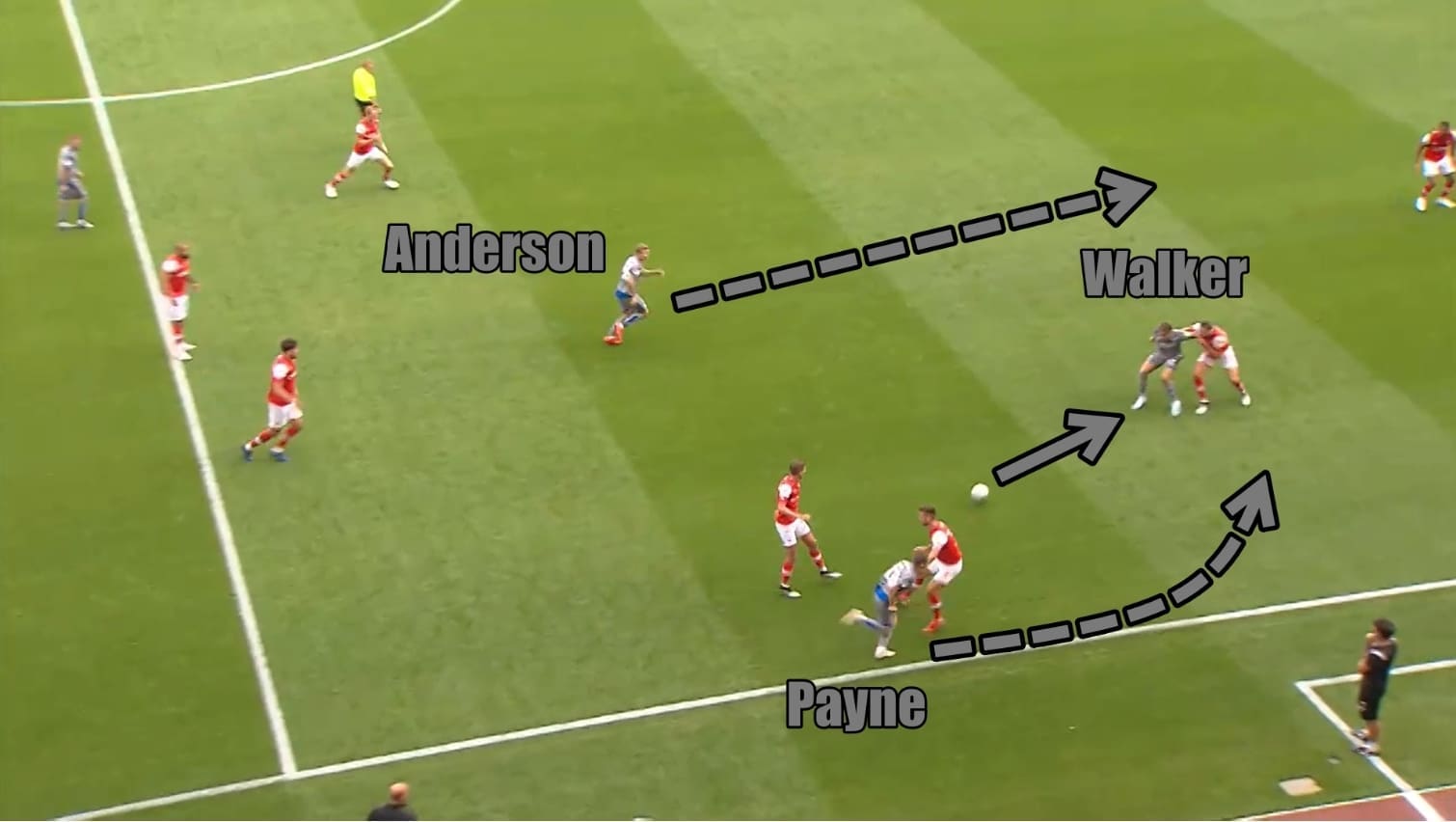
No quality or support
Lincoln made it extremely tough for Rotherham, as they do for any side they come up against, however the instances where the hosts could have capitalised, they were unable to do so. This came down to one of two things: poor assistance of teammates, or poor decision-making.
Looking at the first factor initially, there was no support given to the home side’s attackers when they were faced with openings of which they could have potentially capitalised.
All of the strikers at manager Paul Warne’s disposal are big, powerful forwards who look to dominate physically. The three selected to start here – Smith, Ladapo and Vassell – stand at 6’4”, 6’2” and 6’0” respectively. All look to impose themselves upon defenders (Smith and Vassell especially) and are capable of holding up the ball and winning flick-ons or knock-downs. However, in order for this to be successful, they require their on-running teammates to give them support by offering an option for them to play the ball to. On Saturday, this was too frequently not the case from the Millers’ perspective.
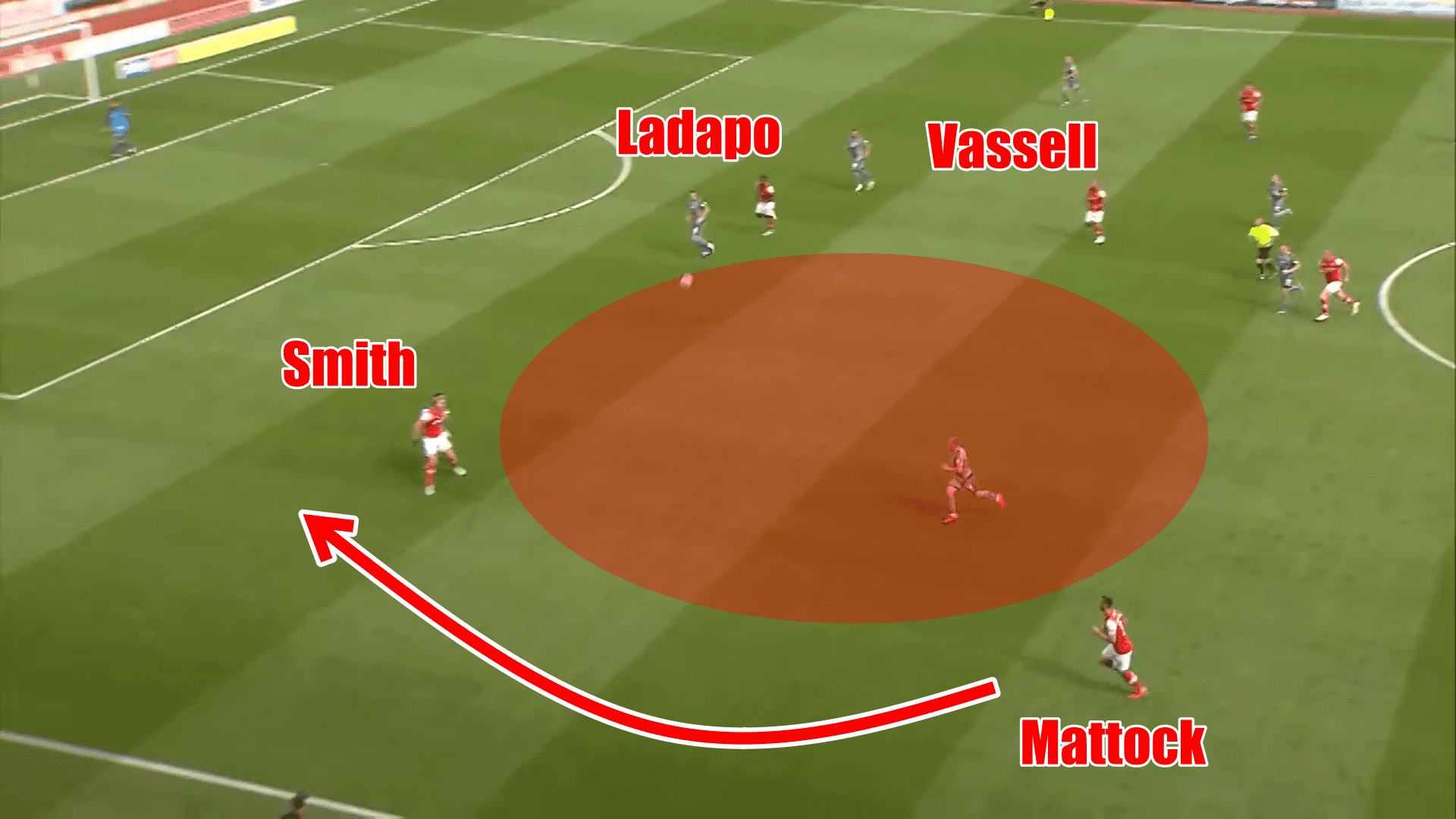
As can be seen in the example above, Smith has pulled across onto the full-back to provide an option on the diagonal. However, there is nobody within 20 metres of him for him to play the ball onto should he be able to either hold it up or flick it on – the vast chasm highlighted by the red circle. Neither of his strike partners are remotely near him; there are no central midfielders running beyond him; left-back Mattock is too deep to offer genuine support. For a team who are set up in order to profit from their frontline’s physical capabilities, this lack of assistance means they cannot be successful in playing in such a way.
Due to their lack of joy when going long, there were also instances where the pace of Ladapo could and should have been taken advantage of, yet either he did not make the correct run or the service from his teammates saw the move break down.
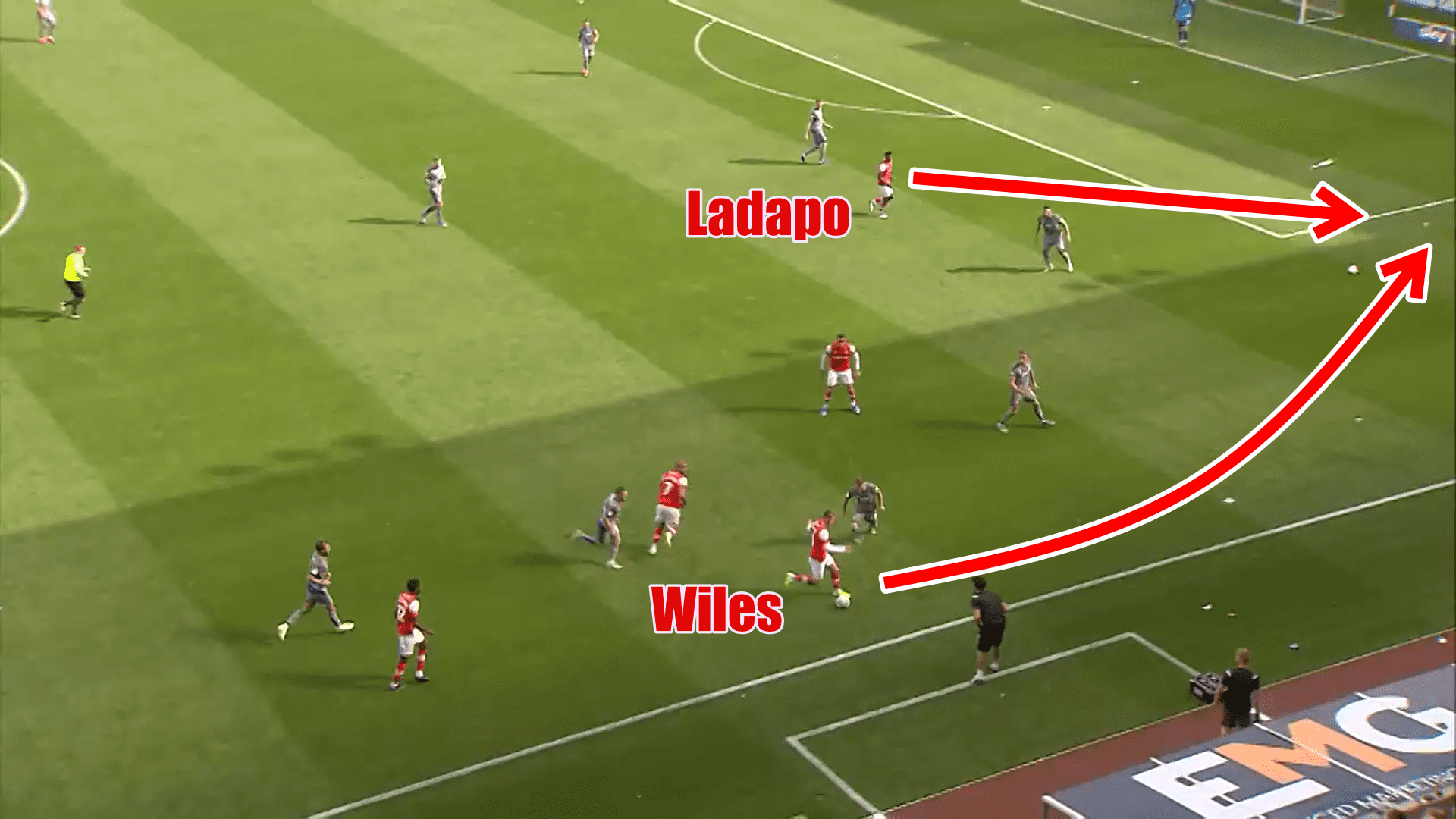
In the above image, substitute Ben Wiles looks to clip a pass down the outside of the Lincoln central defence. However, Ladapo is unaware of this and therefore does not make the corresponding movement in order to run onto the pass. The breakdown of this pattern of play is a clear indication that Warne must look to improve the offensive fluidity and understanding between his attackers.
Building from this, when there were numbers in support of the ball, United were let down by poor decision-making from individuals.
Below, central defender Clark Robertson has stepped out with the ball and broken the Lincoln midfield lines with his pass to Smith. Here, the frontman has a perfect opportunity to turn as he receives the ball, and look to run at the City defence as he has support from several teammates. However, he opts to receive with his back to goal and play backwards again, preventing any benefit from having got beyond the Lincoln midfield that usually protects their defence so well.
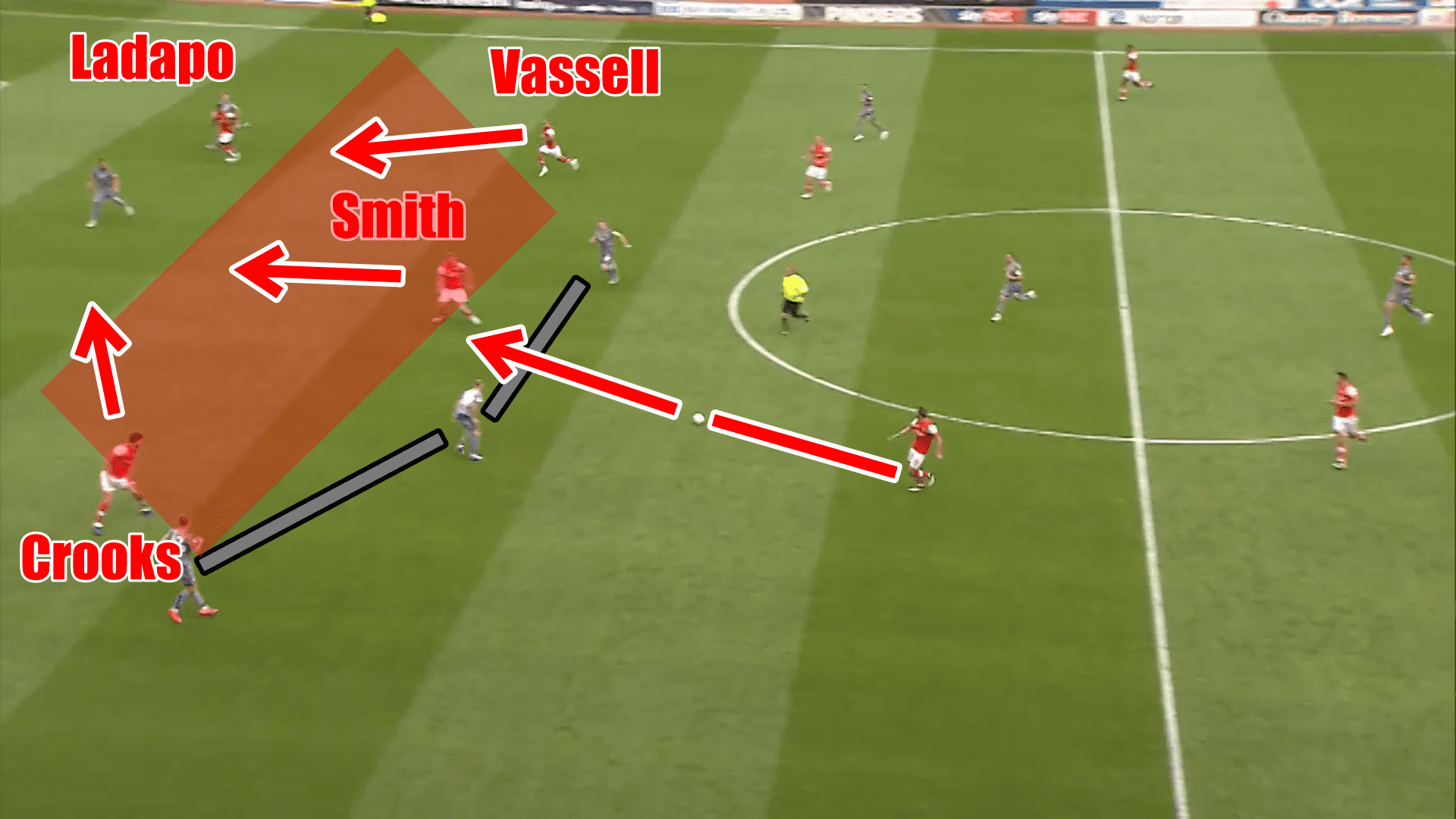
Looking at the Imps’ midfield unit, such is their desire to harangue opponents that there is rarely a second not being hunted down. However, if you can beat this press, then an opportunity opens of which – provided the quality is there – can be capitalised upon. However, Rotherham failed to do so.
The midfield press tactic that Cowley insists upon utilising had been bypassed here, with the ball being played to Smith wide on the right. The Lincoln midfield are the wrong side and thus retreating, with only Anderson in shot such was their desire to press and win the ball back high up the pitch.
Crooks is now given the perfect opportunity to benefit from this, as he is allowed a run untracked into the penalty area having got beyond O’Connor, Morrell and Anderson. With the Lincoln defence occupied with Vassell and Ladapo, he is given free roam of when to go in order to attack the ball.
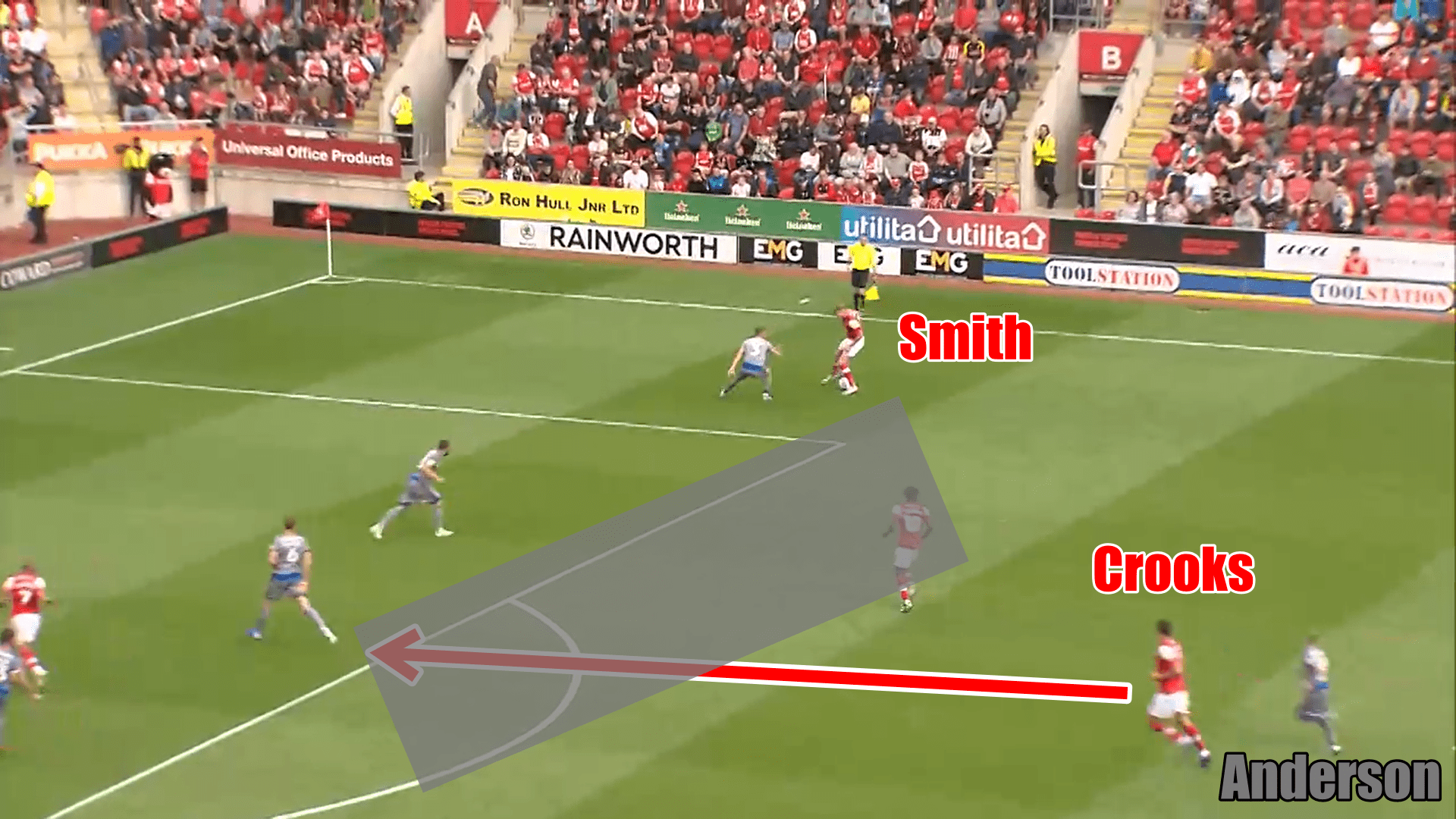
As the ball comes in from Smith, Crooks times his run to perfection in order to arrive unnoticed at the back post. However, Vassell opts to go for goal instead of flicking the ball onto the run onto the midfielder, and the chance is gone. Against such a disciplined side like Lincoln, such rare chances must be capitalised upon. The grey space highlighted is the area vacated by the midfield yet also too far out for the City defensive line to account for too – and must be taken advantage of.
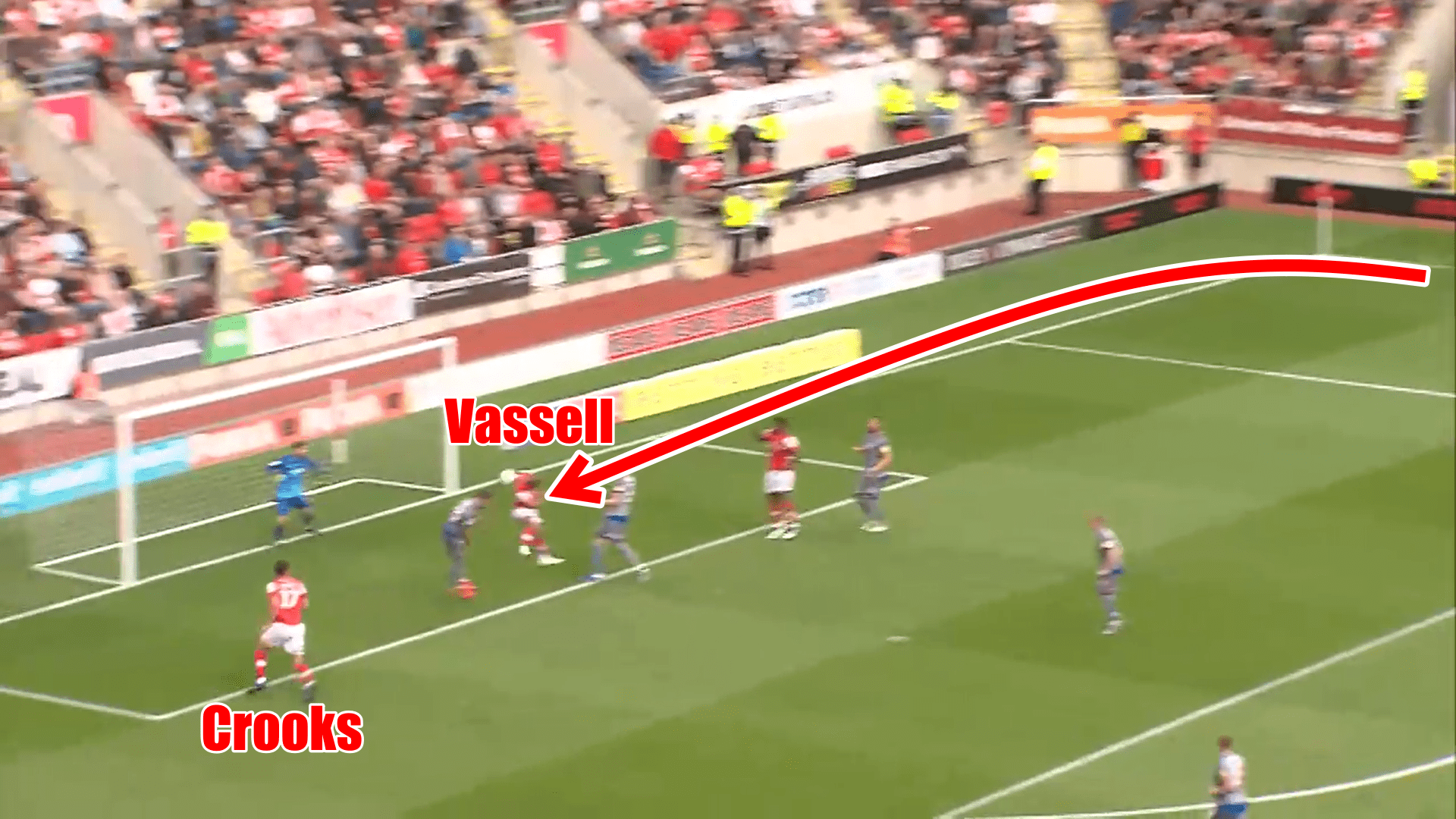
Another very similar instance occurred in the second half, however it was McDonald this time who could not profit from a run off the back of the Imps’ midfield as he headed straight at goalkeeper Josh Vickers. Again, as with Crooks before, he attacked the vacant space between the midfield and the defence, but could not profit.
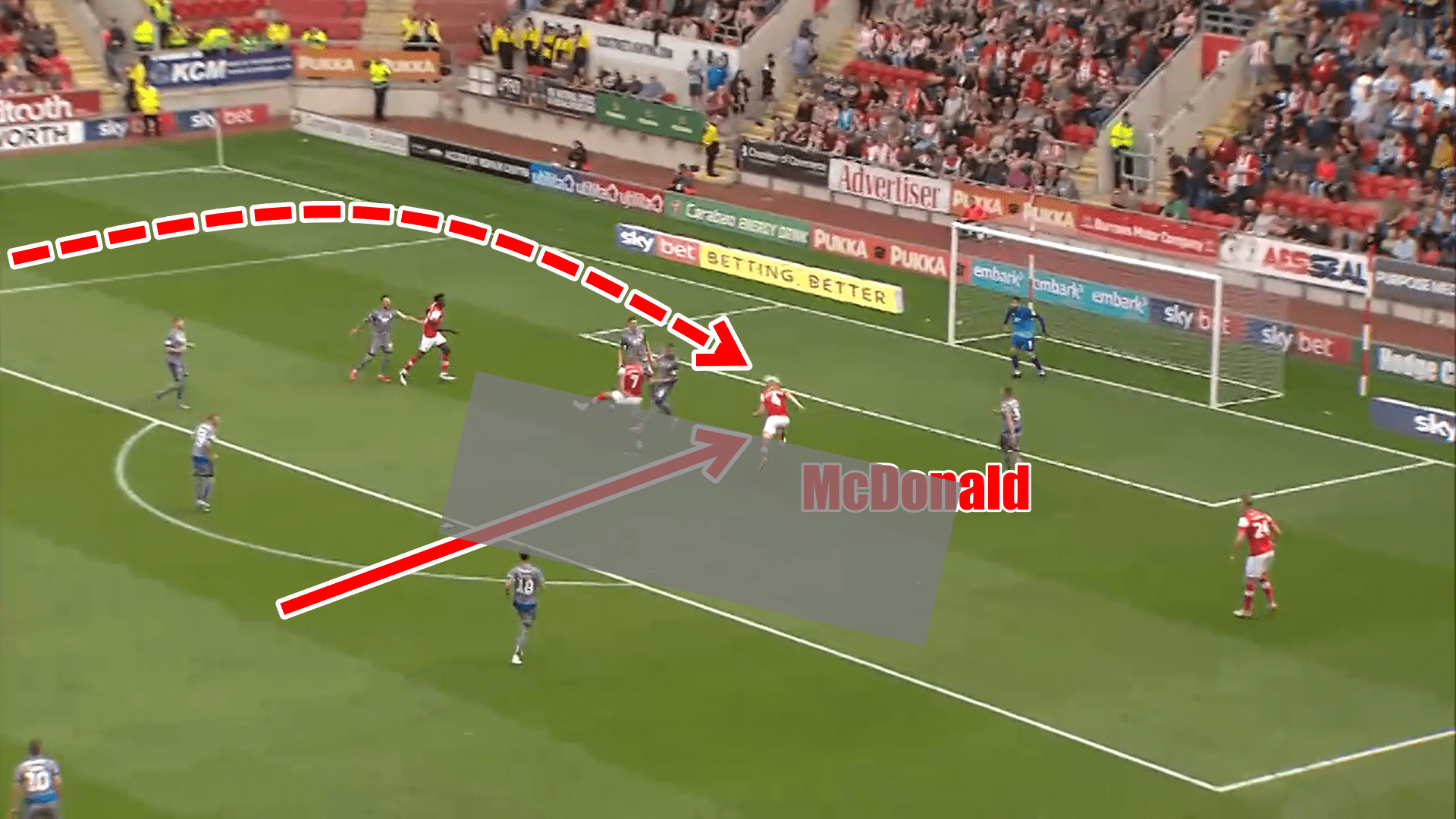
Conclusion
On the balance of play, Rotherham held the advantage in terms of territory for much of the afternoon. However, their visitors were much more clinical and ruthless in front of goal – converting two of their three shots on target – and consequently took the points. Cowley’s men showed exactly why they are such an efficient, well-drilled unit, whilst as for Warne and co., there is certainly plenty of food for thought heading into the forthcoming matches.
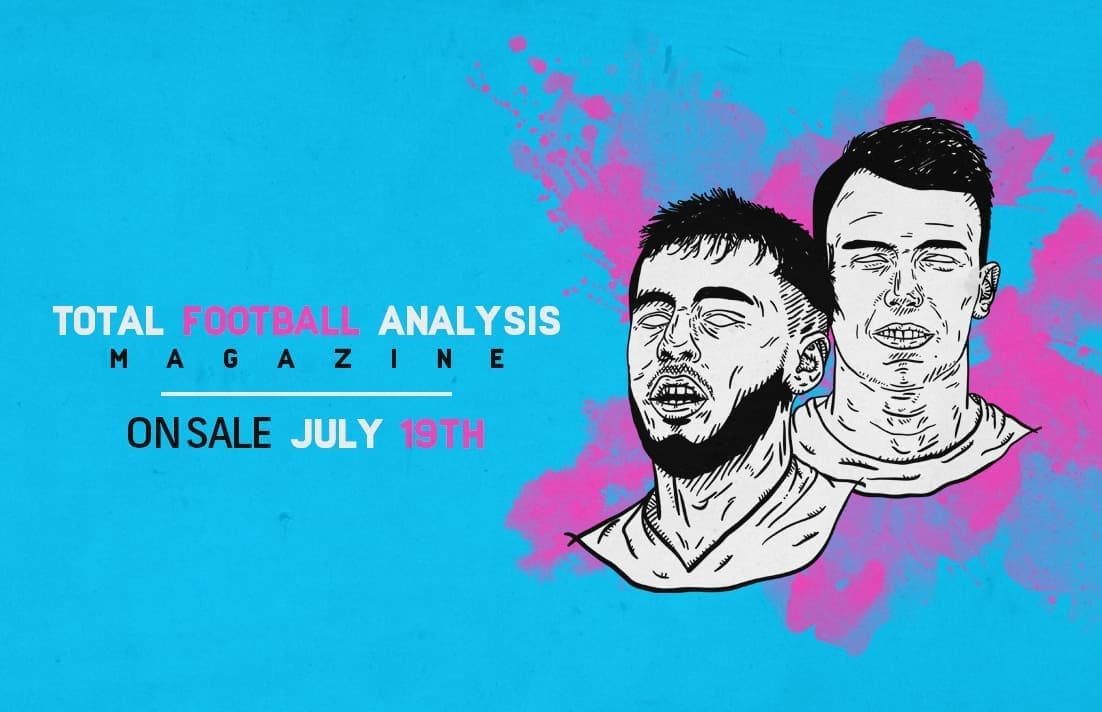
If you love tactical analysis, then you’ll love the digital magazines from totalfootballanalysis.com – a guaranteed 100+ pages of pure tactical analysis covering topics from the Premier League, Serie A, La Liga, Bundesliga and many, many more. Buy your copy of the July issue for just ₤4.99 here, or even better sign up for a ₤50 annual membership (12 monthly issues plus the annual review) right here.

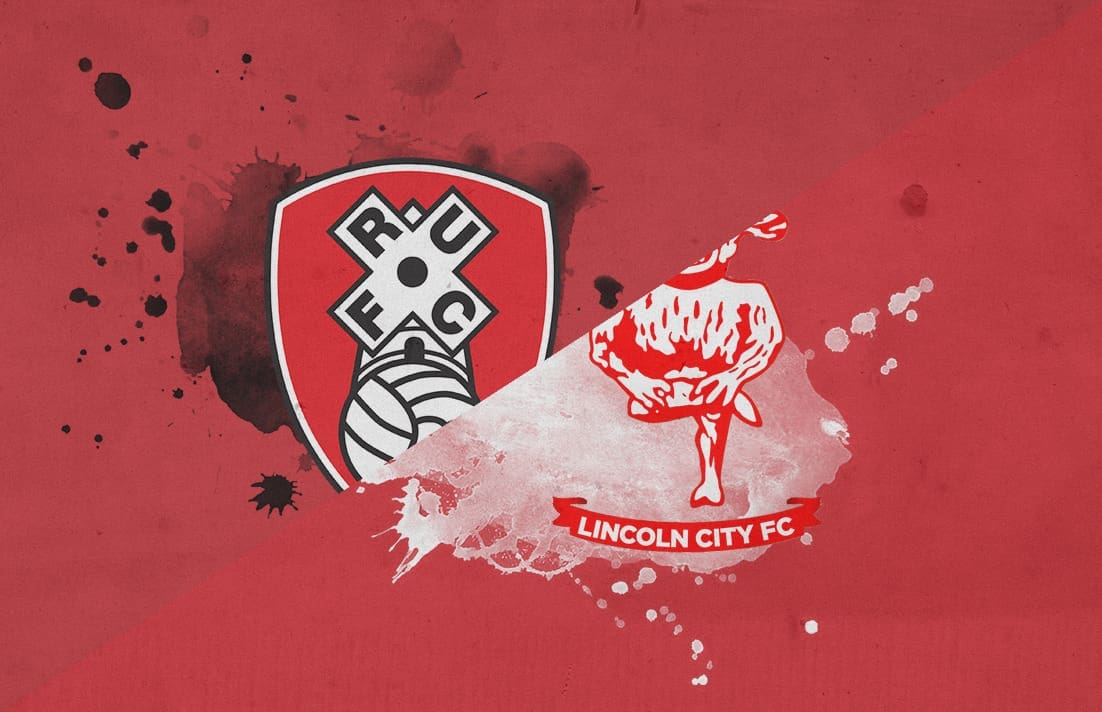




Comments